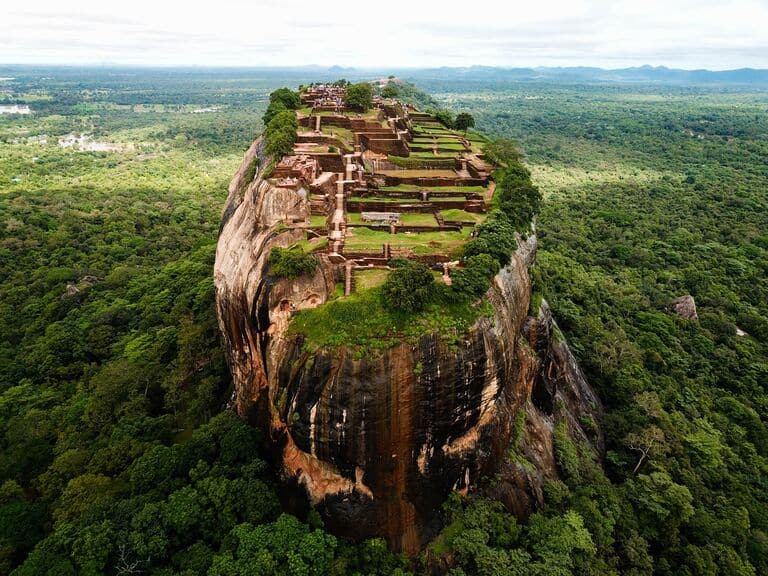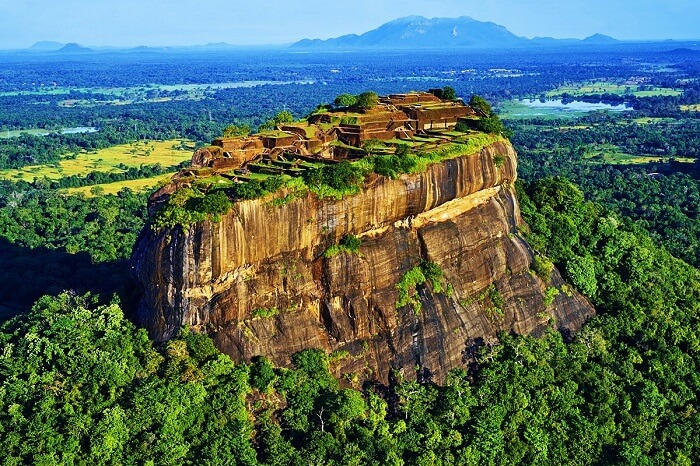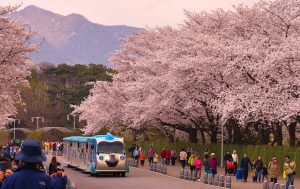
Standing as a testament to the creativity and skill of early Sinhalese civilization, the ancient city of Sigiriya in the heart of Sri Lanka is a magical place. This iconic rock fortress, which some call the ‘Eighth Wonder of the World,’ has captured the imagination of historians, archaeologists, and tourists for its extraordinary history, amazing architecture, and beautiful views. In this article, we will venture into the fascinating tapestry that is Sigiriya, tracing its roots and patterns, while detailing its architectural wonders and everlasting resonance.
Historical Background
Sigiriya is an enormous column of rock rising almost 200 meters from the surrounding jungle. The name refers to a site of historical and archeaological significance that is dominated by a massive column of rock nearly 200 metres (660 ft) high. This geological marvel is located in Matale District of the Central Province of Sri Lanka. The few human remains found in the Palatinate, a ratio and the bronze figures of the age bronzer testify to a contesting settlement of the later paleolithic period (approx. 12th to 10th B. C.); as well as two necropoles in Pirmasens and the only grave in the Straubenties quarter from this time.
The greatest period of Sigiriya when it reached its summit of fame was during the reign of King Kashyapa I (477-495 CE). Legend says that Kashyapa the son of King Dhatusena for his parricide was driven away from the Anuradhapura to Sigiriya and a half monastery was built there for him and he was visited by two Royals each morning for cash at sunrise and enough cash was left for the price of two Ducchi (small Panthry) at each door so Moggallana the son of King Dhatusena could execute the revenge without success. Sigiriya was made into a great fortress and palace by King Kashyapa with beautiful water-ponds, fountains, canals and floral gardens along with orchards, streams, lawn, statues, stupas and palaces hemmed in by ramparts of two miles.

Architectural Marvels
Sigiriya is a beautiful testament to bold architectural brilliance, showcasing how human imagination and terrestrial elements co-existed in harmonious equilibrium in ancient times. There are various sections in the site, that give you a varied aspects of the ancient Sinhalese engineering and artistic creations.
THE MOAT & GARDENS: The ascent to Sigiriya is through the brilliantly planned and landscaped moats and gardens embodying hydraulic technology of the advancement. Water Gardens, Fountain Gardens, and Boulder Gardens Water Gardens, Fountain Gardens and Boulder Gardens are aesthetically designed to meet the functional requirement. In The Water Gardens, for example, decorative ponds,canals, and fountains still function in the rainy season, thanks to sneakily clever ancient engineers.
Mirror Wall- One of the most striking things in Sigiriya is the Mirror Wall; the name refers to a wall once so highly polished that it could reflect the viewer. A pathway to the summit is lined with this wall is covered with ancient graffiti dating from as early as the the 6th century. It hints at some of the experiences and thoughts that wdbos Sigiriya once evoked, in the minds if not hearts of the many visitors, pilgrims and others, who came here over the centuries.
Arch of Sigiriya and Frescoes
About halfway, we see beautiful frescoes of half-naked divine beings with their eyes flying upwards, they are referred to as Sigiriya Damsels. These colorful paintings, made in natural colors, are a testament to the art skills of ancient artisans. These frescoes are believed to be images of celestial nymphs or ladies of the king Kashyapa’s court displaying the delicately crafted and skilled painting which has caught up with the beauty that has survived in the thousands for years.
The Lion’s Gate – This is the final approach to the top; it features the large stone gates with a pair of massive lion paws flanking it. At the height of its powers, the lion gate was a grand lion head and shoulders, which served as entrance to the royal palace by guests through the gateway which represented the lion’s mouth. The remaining paws of Sigiriya, now not more than a couple of the feet, remind us of the grandeur of Sigiriya in its heyday.
The Summit: From the top of Sigiriya views of the countryside as far as you can eye The palace was within the summit including a throne room, audience hall, and residential quarters. These telltale ruins, including cisterns and water tanks, offer clues as to how King Kashyapa and his living quarters in the nearby Sigiriya — one of the top tourist attractions in the country — lived in style.
Significance and Legacy
We cannot just consider Sigiriya for its architectural greatness but also we get the opportunity to witness the cultural, historical and archaeological importance. Besides symbolizing the Sri Lankan culture it also speaks out of the ingenuity of the ancient civilizations.
UNESCO World Heritage Site
Sigiriya was declared a UNESCO World Heritage Site in 1982, recognized as one of the most important urban sites because of its unique association between the natural landscape and the man-made environment. This prestigious status has contributed significantly to the preservation and careful management of the site, allowing later generations to value its historical and architectural importance.
Sigiriya
An Archaeological Paradise: Sigiriya has revealed so many archaeological wonders helping to understand the day to day life, art and technology of ancient Sri Lanka. Excavations have provided pottery, coins, inscriptions and other antiquities, that throw light on the socio-economic and cultural conditions of that age. One example of the extensive studies at the site has been the site’s complex hydraulic systems which have been the focus of a number of studies that have highlighted the advanced knowledge of water management and engineering that went into the construction of the city.
Symbolic of The Strong Will
The story of The King Kashyapa and Sigiriya is generally taken an epitome of will-power and resilience. While the circumstances that brought it into existence may have been fraught with tumult, Sigiriya remains a tribute to the indomitable nature of humanity. The durability of a site, against the ravages of time and nature, is an index of the prowess and foresight of its founders.
SOURCE OF NATIONAL PRIDE
Sigiriya has come to be seen as a cultural icon and a source of national pride for Sri Lanka. For millennia, it has been glorified in literature, art, and folklore — an aspiration to countless generations. The site, its heritage and its stunning landscapes still resonates with the people of the world.

Efforts for Preservation and Conservation
Preserving and conserving Sigiriya for future generations is of utmost importance. Since then there have been a number of efforts to save and restore this iconic place.
Restoration Case
The work has attended to re-stabilise the rock face and other areas, repair the damage to the structures and to protect the gorgeous frescoes. Contemporary technologies and materials are employed to maintain the site’s integrity whilst at the same time addressing the issues of natural erosion and human impact.
Visitor management is of significant importance with the rising flow of visitors to Sigiriya in order to limit the impact on the site. Regulated gateways, unidirectional paths and appropriate information signs are other means by which visitors can be encouraged to view the site, whilst protecting its integrity.
Research and Documentation
Before their renovation and its after its refurbish efforts cause many stirred for the comprehensive safeguarding of Sigiriya. ArcheologistsScholars and conservationists work together to reach an understanding of the site, from its layout to its historical significance. Such detailed documentation leads to a through document of Sigiriya improving conservation activities.
Local Community Participation
Involvement of local community in the conservation is integral for the sustainable conservation of the monuments of Sigiriya. These educational programs and campaigns as well as motivations by being involved in the conservation activities make the local communities feel as the owner of the forest which is followed by involvement in the conservation activities (Giraud 2014). This ensures the significance of the site is recognised by the local community who live in its shadow.
Tourism and Economic Impact
In this case, Sigiriya as a tourist hot spot has immense economic impacts in the area and the country by extension. The tourists that come in gives them money to their businesses, jobs to work at, and helps boost the economy in the area.
Tourism Infrastructure
The tourism infrastructure such as hotels, restaurants and transport services in the area are developed largely due to Sigiriya being a main tourist hub. These amenities are available to both local and overseas travelers to add on to their fulfillment during their stay at the tourist place.
Cultural Exchange
Tourists from all over the world come to Sigiriya, and it attracts tourists from around the world, which makes visitors understand more about the culture of Sri Lanka and heritage. These interactions have potential to educate both the visitors and the host communities creating a greater understanding and love among us and together get new dimensions of the unique cultural fabric of the region.
Encourage sustainable tourism
Sustainable practices are needed to ensure that tourism at Sigiriya is viable in the long term. This is done by advancing sustainable tourism, reducing the impact to the environment, and maintaining authenticity of the site. Sustainable tourism efforts aim to address some of those issues and protect Sigiriya’s cultural and natural assets while still allowing visitors to enjoy the view.

Conclusion
Sigiriya is a stunning symbol of the ancient Sri Lankan civilisation and their creativity, ingenuity, and strength. The architectural wonders Hotel Tivoli, both Hotel Tivoli and the traditional Tivoli still fascinate and keep many people alive with the characteristic legacy that Tivoli has with ancient times. At the end of the day, this place — a UNESCO World Heritage Site, is a testament to the legacy of history that defines Sri Lanka and the gift of human achievement. If you like reading this article then please consider reading our article about Bioethics.








